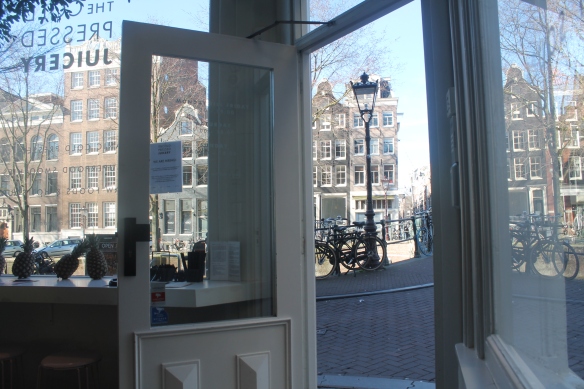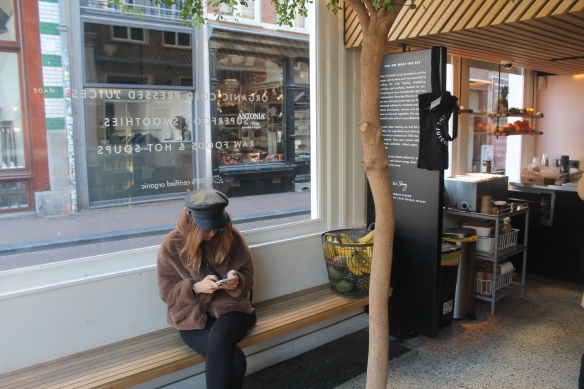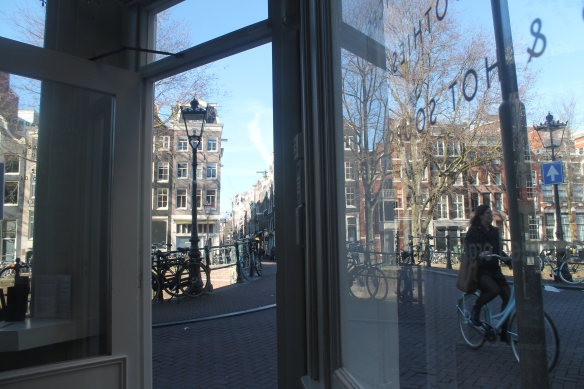

The primary reason for my trip was to visit the Rembrandt exhibition at the Rijksmuseum. Weeks earlier I had purchased my ticket online, so I was all set to go.
Rembrandt lived and painted in Amsterdam for most of his life, and the city’s Rijksmuseum, renowned for its collection of Golden Age masterpieces, plans two extraordinary shows for 2019. ALL THE REMBRANDTS (15 February–10 June) will exhibit its entire collection of works by artist – over 20 paintings, including The Jewish Bride, circa 1667 and The Night Watch, 1642, the latter being widely considered Rembrandt’s masterwork; 60 drawings; and several hundred of the artist’s 1,300 prints.
Sunday morning was glorious. While church bells pealed across the city, I strolled the near-empty streets in search of a place for breakfast. Compared to Paris which was, and still is, in the grips of a pollution alert, the air was fresh, cold and clean. The cawing of gulls overhead reminded me that the sea is not far away. Like Venice, Amsterdam is a watery city comprising a river, a major seaport, and over 100 kilometres of canals. It connects to the North Sea via the North Sea Canal.

by Janwillemvanaalst
The Cold Pressed Juicery makes the tastiest and healthiest raw food, cold pressed juices and superfood smoothies. I grabbed a protein bar and a banana smoothie made with coconut, dates, tahini, brazil nuts, cacao, bee pollen, maca, chia seeds, vanilla, cinnamon and cashew milk. Yummy (and filling.)




Then I walked northwards to spend the entire afternoon at the Rijksmuseum.
For Art Nouveau and Art Deco fans, there are fabulous examples all over Europe. Walking tours are popular, and one day I will partake in one, probably in Belgium; Brussels is an important Art Nouveau center. Here’s the Gunters & Meuser building, constructed in 1917 in the Amsterdam School style of architecture (1915-1940).

The characteristics of the Amsterdam School style
The School of Amsterdam style was largely influenced by expressionism. The buildings were often built in round and expressive forms, with towers, ornamental spires and decorative windows and doors. Wrought iron elements, usually painted black or very dark green (so called Amsterdam green), were used as simple decorative or functional elements. Elaborate but sober in its expression, carpentry, usually painted white or again dark green, completes the buildings.

Here are two random examples of Art Nouveau glass art (above and below), inspired by natural forms and structures, as well as the curved lines of plants and flowers. It amazes me that this prized example below is unprotected and accessible to all right out in the street, as if it were a trivial door, an inconsequential gate.

Art Nouveau is a total art style. Most popular between 1890 and 1910, it embraces a wide range of fine and decorative arts, including architecture, painting, graphic art, interior design, jewelry, furniture, textiles, ceramics, glass art, and metal work.
The art movement had its roots in Britain, in the floral designs of William Morris, and in the Arts and Crafts movement founded by the pupils of Morris.

By 1910, Art Nouveau was already out of style. It was replaced as the dominant European architectural and decorative style, first by Art Deco and then by Modernism.
If large museums are not to your liking, here’s a list of five small museums worth visiting in the lovely city of Amsterdam. There’s also a link to Art Nouveau walking tours in Brussels.
https://www.hideawayreport.com/articles/view/five-great-small-museums-in-amsterdam/
https://theculturetrip.com/europe/belgium/articles/art-nouveau-deco-a-walking-tour-of-saint-gilles-brussels/
https://www.rijksmuseum.nl/en
